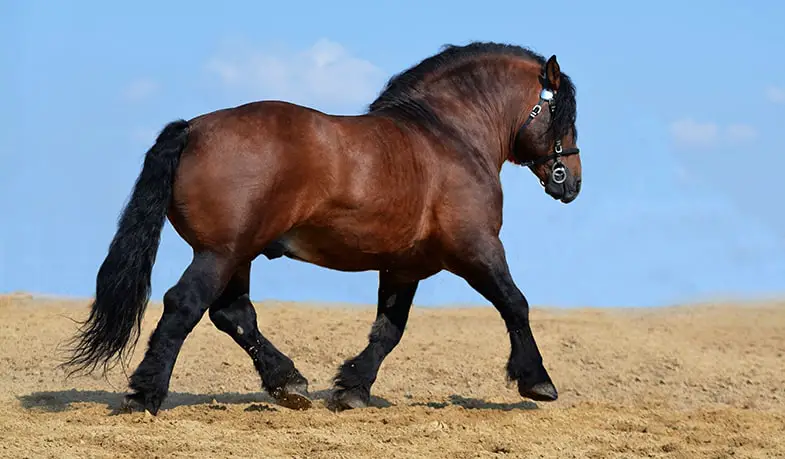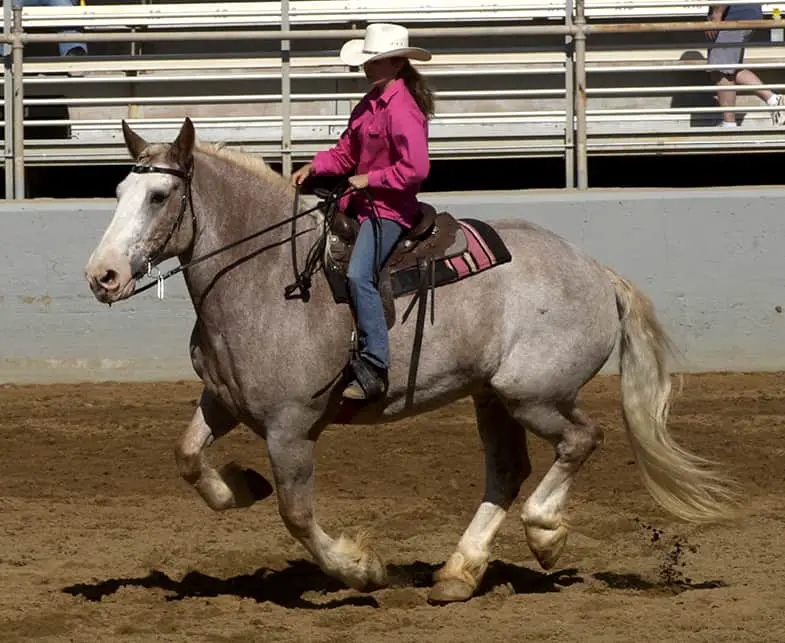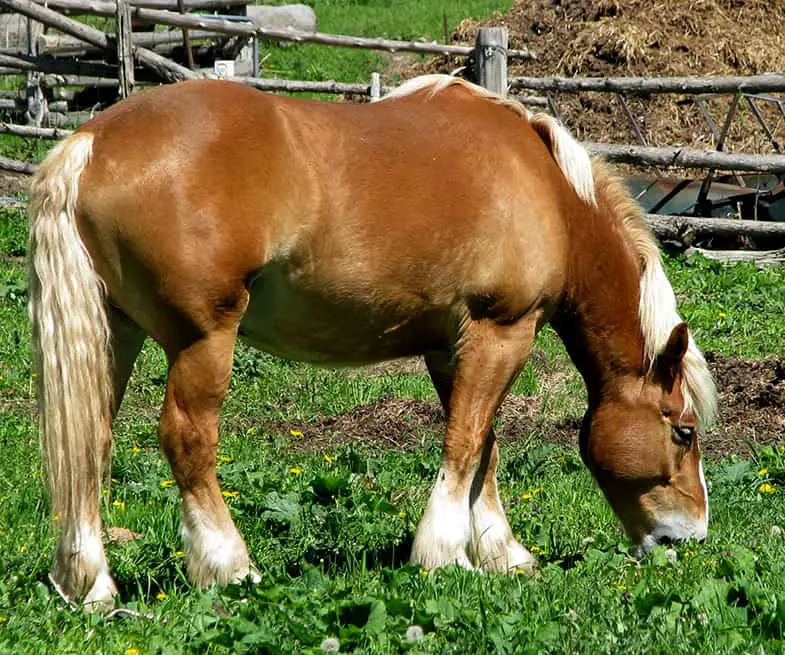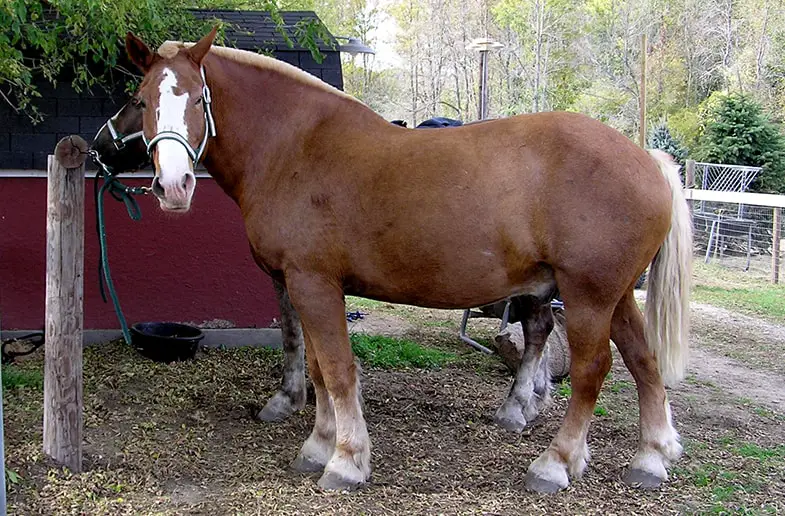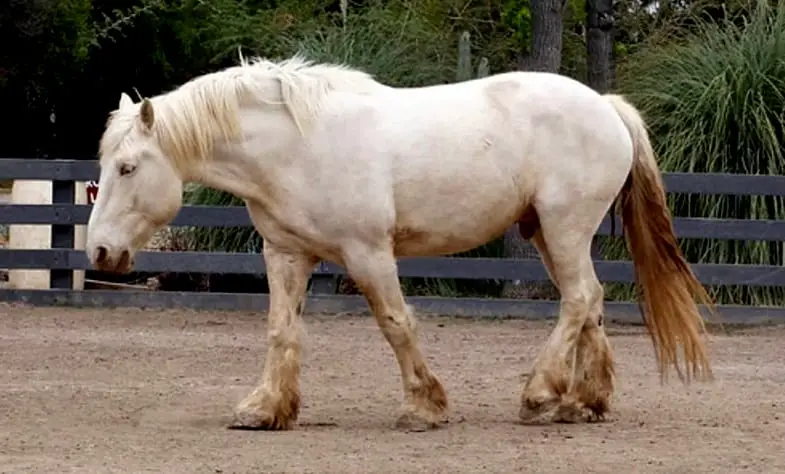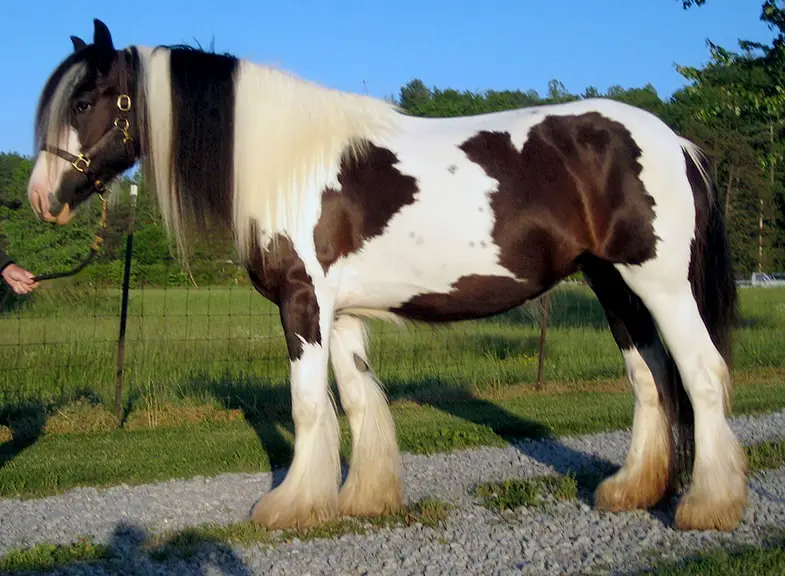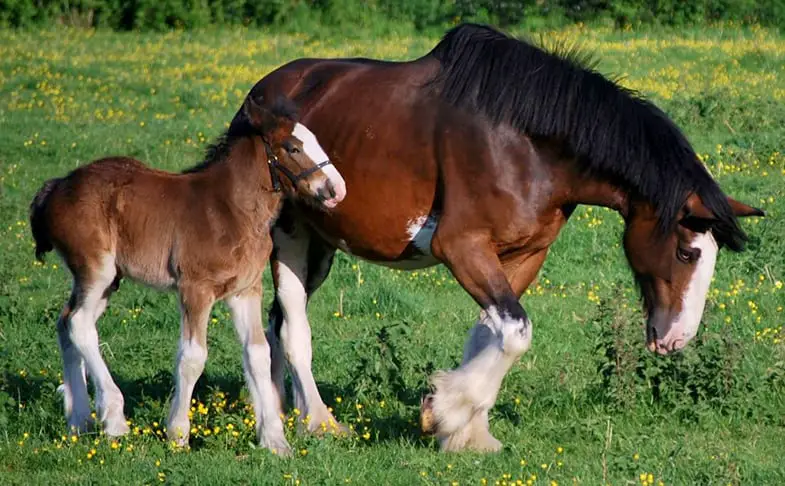Regardless of whether you’re looking for your first horse or have owned dozens before, buying a horse is always a big decision and one that should only be made with careful consideration. While light horses may be more common, there’s no denying that heavy draft horses (such as the Percheron and Clydesdale) are steadily growing in popularity.
I know that owning a heavy draft horse isn’t for everybody but let’s be honest, owning a horse of any kind is a big step, so it’s always a good idea to weigh up the pros and cons before deciding if a draft horse really is for you or not.
| ProsConsKind temperamentsExpensive to care forTolerant of mistakesProne to PSSMNot prone to spookingHarder to buy tack forMore sensible than other horsesDifficult to find a farrierComfortable to rideBuilt for strength not speedGreat for beginnersProne to heat stressCan be ridden or drivenDifficult to keep fitExtremely surefootedStronger than most horsesHappy in cold weatherMuch higher if you fallGreat for making friendsDifficult to get on by yourself |
|---|
Pros
If you’re thinking about buying a draft horse it’s obviously important to consider the negatives but this means that the positives (which are equally as important) are often overlooked.
Draft horses are gentle giants that are eager to please
Kind temperaments
There’s a reason why draft horses are often described as gentle giants and that’s because of their temperaments. They’re known for generous, willing, and affectionate natures and are happy to please. Their placid nature means that they can often be handled by adults and children.
I once heard somebody describe their draft horse as being a living rocking horse. They said that the ride was so comfortable and the horse had such a laid back nature it reminded them of a rocking horse.
Not prone to spooking
It’s often said that the bigger the horse the calmer the disposition and draft horses are no exception to this. They are extremely sensible horses that are so laid back they’ll rarely bat an eyelid at the scariest of monsters!
In fact, they’re so laid back and bombproof that they’re often used to help train younger horses, especially if the young horse is nervous. Horses feed off of other horses’ emotions so if a young horse sees calm horses around them they’ll be less likely to be nervous themselves.
Great for beginners
While some people may find their size intimidating they can actually be really good horses for novice riders and first-time owners. This is largely thanks to their gentle, docile natures, although I would add the caveat that the horse should be older and well trained.
They will be very tolerant and forgiving of any beginner mistakes and won’t hold a grudge if you make a mistake or tell them off. They also have quiet natures that can help to improve the confidence of a nervous rider.
Comfortable to ride
Being big horses, they tend to have longer strides which means that not only will they cover the ground relatively easily but that their gaits tend to be smooth, especially at a walk and trot or jog.
Their large, rounded backs also give the rider a comfortable seat, regardless of whether or not the horse is moving. I once heard somebody describe their Percheron as being so comfortable and having such a relaxed pace it was like riding a couch.
Riding a draft horse is like riding a couch, they’re so comfortable
More versatile than you might think
You might think that their build means that they’ll only ever be suited to slow-paced pleasure rides but this couldn’t be further from reality. While draft horses are unlikely to break any records or set scores alight at higher-level competition events they are extremely versatile horses that will certainly try anything.
Whether it’s barrel racing, dressage or even eventing draft horses can be seen competing in most disciplines – often doing better than you might think.
Can be driven too
Having originally been bred for agricultural work, draft horses were often required to pull heavy loads over long distances, a characteristic that meant they evolved to be able to pull up to 150% of their own body weight.
While they’re very rarely used on farms these days they still have the ability to pull a phenomenal amount which is why they’re still a popular choice for pulling drays and carriages. This means that if you fancy a change from riding then you can easily hitch your draft horse up and go for a drive instead.
Can be cheaper than a lighter horse to buy
While the average draft horse will probably cost the same as that of a lighter horse some breeders and registries will offer incentives to encourage you to buy a draft horse. The main reason they do this is to increase awareness of the breed.
These enticements can range from reducing the initial cost of purchasing the horse to selling the horse with the tack.
May need fewer calories
A 2007 study into the nutritional requirements of horses (carried out by the National Research Council) found that, pound for pound, draft horses actually need fewer daily calories when they’re at rest than lighter breeds such as the Thoroughbred.
This is in part due to the fact that they don’t need to keep active and have been bred to be able to work for long periods of time with little food. That’s not to say you can feed your horse less but that they may not need as much food as you might think, that said though you should always follow your veterinarian or equine nutritionist’s advice.
Extremely surefooted
Having been originally bred to work on uneven terrain, many draft horses have evolved to be tremendously surefooted on the dodgiest of ground while also possessing a great deal of strength in their legs. This means that they make excellent, if somewhat unconventional, trail mounts, especially over rocky ground.
While draft horses are naturally surefooted they also generally have big, hard hooves that help to dissipate a lot of unevenness on the ground which makes them very comfortable to ride over rough ground.
More than happy living in colder climates
If you live in an area that gets really cold during the winter you’ll know that it can be expensive to keep your horse warm when you need to increase their hay consumption and buy multiple blankets but with draft horses, you don’t always need to do this.
Of course, you’ll still need to increase their forage but their thick skins and heavy coats mean that they don’t often need to be blanketed. Even if you keep them turned out, a proper shelter or run-in will be more than enough for them.
You own a piece of history
Okay so this may be a bit of a wild card but some people like draft horses for their nostalgic appeal. Whether you hanker after the ‘good old days’ before mechanization or like the thought of riding a horse that once carried knights into battle draft horses have it all.
While today’s draft horse may bear little resemblance to the ancient horses of the Middle Ages they still share their ancestry with them which can give you a sense of riding a piece of history.
Great fun and great for making friends
I know not everybody will agree with me but draft horses are eager to please their owners and are willing to try everything asked of them. They’re also header turners and conversation starters too so you’ll never be stuck for something to talk about again.
At a recent open show, there was a girl who turned up on an 18.2hh (73 inches) Clydesdale, she was new to the area and didn’t know many people but before the day was over had made so many new friends. Everybody wanted to know more about her horse!
Cons
The sheer size of a draft horse is enough to put some people off, but if you’re not one of those people then you should also consider the negative aspects of owning such a big horse.
It can be difficult to find tack that fits a draft horse
Expensive to care for
Many horse owners joke that buying a horse is the cheap part and that paying for their care and upkeep is what really costs but this is even truer for draft horses. Their size means that they’ll need more food, a bigger stall, and even more bedding.
When deworming, or administering medicine to your horse you’ll need to take your horse’s size (and weight) into account and alter the dose accordingly. This is likely to increase the costs considerably, although vaccines aren’t based on the horse’s size so the cost of these shouldn’t be any higher.
Prone to Polysaccharide Storage Myopathy
Many draft breeds (such as the Percheron and Belgian) are prone to a condition known as Equine Polysaccharide Storage Myopathy (also known as PSSM or EPSM), a genetic muscle disease that causes the horse to accumulate unnatural amounts of glycogen (sugar). This can be extremely painful and stressful for the horse and needs to be treated immediately.
Many vets will recommend a special PSSM diet that is high in fat and fiber but low in sugars and starch although this isn’t always enough. You also need to monitor what a horse with PSSM eats very closely as they can’t have too much sugar or starch.
Harder to buy tack for
You might think that you can simply buy the largest saddle in the shop and it’ll fit your draft horse but sadly it doesn’t work like this. Lighter horses tend to have more arched backs so a saddle designed for a Quarter Horse is unlikely to fit a draft horse with a much rounder back.
Some tack shops may be able to find things for you but sourcing tack is probably the number one complaint you’ll hear from draft horse owners. And I do mean tack, not just saddles, draft horses also have bigger heads that often won’t fit inside a ‘draft sized’ halter or bridle. Not only is it much harder to find it’s also a lot more expensive too.
Draft horses also grow at a slower rate than other horses so it won’t be until the horse has reached the age of 6 that you’ll know exactly what size tack they need.
Difficult to find a farrier
You might think that just because your farrier looks after your current horse’s feet he’ll be happy to do the same for a draft horse but this isn’t always the case. Finding a farrier that is happy to work with draft horses, regardless of whether or not their shod, is like finding the proverbial needle in a haystack.
Once you have found a farrier that’s happy to look after your horse you’ll find that the cost is much higher too. Some farriers will charge twice as much for trimming/shoeing a draft horse due to the size of their feet.
You’ll need a bigger trailer
If you need to transport your draft horse anywhere you’ll soon find that normal trailers just won’t do. You’ll either need a trailer that’s been designed especially for heavy horses or one that is big enough to carry at least two horses at a slant.
As well as being taller and wider than most other horses, many draft horses are surprisingly longer too. This means that a small, side-by-side, two-horse trailer probably won’t be big enough. Instead, you’ll need a slant loading trailer with adjustable dividers, this will give your horse the space of two sections so he’ll be comfortable while in transit.
Built for strength rather than speed
If you’re a bit of a speed freak them I’m afraid that a draft horse isn’t going to be right for you. Yes, they can pick up a fair amount of speed compared to us, but there’s no way a draft horse is ever going to beat a lighter horse. Not even downhill with the wind helping them.
Their build also means that they aren’t able to flex their body’s enough to compete successfully at dressage while their weight means that jumping should be kept to a minimum in order to avoid unnecessary stress and concussion on their forelegs.
Prone to heat stress
Having mainly evolved in colder climates draft horses have developed thick skins and heavy coats to help them to stay warm during the long, snow-filled winter months. While this is great if you live in one of those countries it can be a real problem if you live in a hotter country.
Their thick coats and bulky bodies work to keep the heat in which can be great in the snow but not so good in the summer. It can be very difficult for them to cool down, making them far more susceptible to heat stress and even dehydration.
Some riders, in hotter countries, exercise their horses easy in the morning before the sun has had a chance to fully warm everything up in order to reduce the chances of the horse overheating.
Thick hair can cause skin conditions
While their heavy coats mean they’ll be comfortable in the harshest of winters it does come with its own set of problems. Namely, a serious skin condition known as chronic progressive lymphedema, which causes skin lesions. This can often result in secondary infections which can be serious if not treated.
Some people completely clip a horse’s feathers in order to prevent mites. Mites like the warm dark folds in the lower legs and with heavy feathering around the feet and lower legs often live there undetected.
Difficult to keep fit
Draft horses have always been bred for power rather than for their athleticism which means that they can often find it difficult to maintain a trot or lope for prolonged periods. While this might not seem like a problem at first it does mean that it can be very difficult to improve their fitness and even harder to maintain it.
On the plus side though, if you are able to maintain their fitness levels then you’ll find you have a very willing horse that can comfortably carry you all day long at most paces.
Much stronger than lighter horses
Yes, draft horses are gentle giants but these giants still possess an awful lot of power which can make them difficult to handle if they decide they don’t want to do something.
Thankfully this is rarely the case but you need to seriously ask yourself what you’d do if you were out riding on your own and your horse spooked at something. Would you honestly be able to stop them and bring them back under control?
You’ll also need to make sure that all of your fences are properly maintained and strong enough to keep your horse safe. Many people have an electric primary fence to prevent their draft horses from destroying the fence with an overly enthusiastic scratch.
They’re much taller (and heavier) than lighter horses
I know I’m stating the obvious by saying that draft horses are bigger than lighter horses but this comes with other drawbacks that you might not have thought about.
A long way to fall: While nobody wants to fall from any horse unexpectedly dismounting from a draft horse could be more problematic than you might think at first. Of course you’ll have further to fall but this increased height means that you’ll be more likely to hit the ground harder than you would if you were falling from a ‘normal’ sized horse. This means that body protectors are an absolute must.
Step up: Some people train their horses to lower their heads on command in order to make putting a halter or bridle on much easier. Even if you buy a horse that has been trained to lower its head you’ll probably still need to use a step or low ladder to put a saddle on as well as to groom your horse.
Mounting: Their height can also make mount difficult, especially if you don’t have a mounting block or friend to help you get up. As a result of this many people train their horses to stand by a step to make mounting easier, but if you need to remount while out this isn’t always going to be possible.
Head clearance: You may have a better view being higher up but if you’re out on a trail you’ll have to be careful of lower tree branches. Your horse will avoid any branches that may come his way but he won’t even think about the extra height you’ll be adding so you’ll have to watch out for these yourself and take evasive action.
Personal space: Like all horses, they need to be taught to respect your personal space, but this is even more important with draft horses due to their big, heavy feet and their weight. They’re often not aware of where they’re putting their feet and can easily step on yours. This, of course, can be painful regardless of the horse’s weight, but with draft horses, it can very easily leave you with broken bones in your foot. On top of that, it’s not so easy to push a draft horse off of your foot either – their thick, muscular shoulders mean they can’t always feel you pushing.
Some breeds can be clumsy
While draft horses are generally very surefooted some breeds, such as the Clydesdale, are prone to tripping. They rarely trip so badly that they fall to the ground but it can happen. This isn’t, of course, true of every horse (or even of every Clydesdale) but it’s always a good idea to have a farrier check the horse’s feet prior to purchasing though.
Which drafts breeds are best for riding?
Okay, you’ve read all of the pros and cons and have decided that a heavy draft horse is exactly what you want, the next step is to decide what horse to go for. Each breed has its own set of characteristics and personality traits so there is a large amount of personal preference involved.
The horse you ultimately end up with may, in part, be due to where you live. Some breeds are more popular in some countries than they are in others so it’s important to take this into consideration when looking for a horse.
Breeds such as the Percheron and Clydesdale are highly popular these days in many countries around the world while other breeds such as the Shire Horse are sadly pretty rare.
If you’re still not sure what breed is best for you and want to know more about draft breeds in general then you’ll find this article I wrote recently helpful. It talks about the 15 most popular draft horse breeds in the world.
What’s the alternatives to owning a draft horse?
If, after weighing up the pros and cons, you decide that owning a draft horse isn’t for you but still like the idea then why not consider a half draft cross instead such as a Percheron and Paint Horse cross?
This way you still get to own a big horse (typically ranging from 16hh to 19hh (64 to 76 inches)) with all of the benefits of a draft horse but that is more manageable. Most half draft horses are a result of breeding a draft mare with a lighter horse so you’re also less likely to get a horse with some of the genetic conditions draft horses have. Unless of course they’re crossed with another breed that has the same condition such as the Quarter Horse in the case of PSSM.
Interesting facts about draft horses
Okay so I admit this section isn’t a pro or con but while researching this article I can across some really interesting facts that I thought I’d share with you.
Double trouble
Horses aren’t known for having twins but you might be surprised to know that draft horses are around 25% more likely to have twins than any other horse. This is because when a draft mare is in heat she’s more likely to produce two eggs at the same time.
While conceiving twins is one thing, giving birth to two healthy foals is another matter entirely yet this is something that’s far more common in draft horses too. They have a much larger uterus than their lighter counterparts so are more likely to carry their twins to full term.
A long history
You might think that many draft breeds were specially bred for agricultural purposes but, while this is true, their history can in fact be traced right back to medieval chargers such as the Great Horse and the Destrier.
While these famous charges may have been much lighter in build than today’s draft horses they were often crossed with cold-blooded breeds to produce many of the draft horses we all know and love today.
Why do draft horses have furry feet?
Ask most people to describe a draft horse and they’ll probably mention the thick hairy (known as feathers) that cover their lower legs yet you might be surprised to know why some breeds have these.
While not all breeds have these feathery legs those that do all share one thing in common and that’s their native habitat. Generally found in breeds that originally lived in colder climates, these feathers were designed to keep the horse’s lower legs warm and dry while they were working in the cold wet conditions.
I hope you found this article helpful. If you did I’d be grateful if you could share it please as it would really help me.
Recommended products
Over the years I have tried hundreds of different horsey products, from various blankets and halters to different treats. Some I’ve loved, others I’ve hated but I thought I’d share with you my top all-time favorite products, the ones I never leave the yard without. I’ve included links to the products (which are in no particular order) that I really think are great.
- Horse Knots by Reference Ready – If you’re like me and enjoy pocket reference guides then you’ll love this knot tying guide. These handy cards can easily fit in your pocket or attach to the saddle for quick reference. They’re waterproof, durable and are color coded to make them easy to follow.
- Mane ’n Tail Detangler – Even if you never show your horse you’ll need to detangle his tail from time to time (and possibly his mane too) which is always a challenging chore! I’ve found that if I run a little bit of detangler through my horse’s tails every few days it stops them from getting matted up and makes combing them easy, even if they’re coated in mud. I don’t know if I should admit to this or not but it also works wonders on my hair.
- TAKEKIT Pro clippers – Over the years I’ve tried a lot of different clippers and while some were obviously better than others I found these to be by far the best. They are heavier than a lot of other clippers but for me, that’s a good thing, it makes them feel more sturdy and hardwearing. On top of that they have a range of speeds so are just as good for clipping your horse’s back as they are his face. I also like the fact that they come in a handy carry case but that’s not for everybody. The company that makes them is super good and incredibly helpful too, a real bonus these days. The only thing I wasn’t keen on was the fact that it doesn’t come with any oil, but that’s not a major problem as it’s not difficult to buy lubricant.
- Shire’s ball feeder – There are so many boredom buster toys out there but I like to use these every day, regardless of whether or not my horses are bored. I find that it helps to encourage my horses to problem solve by rewarding them with treats (or pieces of fruit) but it also mimics their natural grazing behavior which helps to keep them calm and de-stressed.
- Horse safe mirror – This is a strange one that many people are surprised about but I like to put horse safe mirrors in the trailers as well as in the quarantine stalls. It helps to prevent the feeling of isolation by giving the impression of other horses being around. Being herd animals horses can get extremely stressed when they feel that they’re on their own but with these stick-on mirrors, they believe that at least one other horse is with them.
- Rectal thermometer – I know this isn’t glamourous at all but it’s vital for your horse’s well-being to be able to check their temperature and a rectal thermometer is the easiest way of doing this which is why I’ve added it to the list.
Shopping lists
I’ve also put together a few shopping lists of essential items that I’ve found helpful over the years. I’ve broken the lists down into different categories rather than put everything in one massive list 😉

